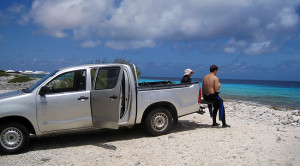Island Getaway: Diving & dining on a trip to Bonaire

Usually, I describe Bonaire’s location by holding up three fingers of my left hand like I’m covering each island with a finger and say, “There are three islands: Aruba, Curaçao and Bonaire. They’re about 50 miles off the coast of Venezuela.” Everyone has heard of Aruba – undoubtedly because of the Beach Boys song. A few people have heard of Curaçao. My theory is they know it from the blue orange liquor. Only divers have heard of Bonaire. The three islands, well south of the hurricane belt, all make for spectacular diving, but Bonaire is different for the simple reason that most of the dive sites can be reached by pickup truck – no boats are necessary.
Driving to your dive site might not sound that exciting, but it is if you hate being up at a specific time to be at the dock to meet your boat. The two-tank trip you had in the morning isn’t enough? Grab some more tanks and do as many dives as you like. Most car rentals are four-door Toyota pickups with tank racks in the back. Load up your tanks in the morning (or in the afternoon like we did) and drive to one of the 80+ dive sites along the coast: each is marked along the road with a yellow rock with the site name in black. Just pull your truck onto the chunk coral beach, gear up and walk in. The reef is anywhere from 20 to 100 feet offshore.
The reefs here are beautiful. Bonaire had the foresight to protect their reefs and made the area surrounding the island a marine park in 1979. Since then, there has been no fishing or anchoring near shore and the reefs here are some of the richest in the western hemisphere. I’m partial to the angelfish and parrotfish, but I spend every safety stop looking closely in the soft coral for seahorses.
Bonaire is a cool amalgam of different cultures. Locals are all multilingual: Dutch, Papiamentu, Spanish and English are the most common languages. There are more Dutch and German vacationers here than American, but the local currency is the U.S. Dollar – no currency exchange and no additional fees on your credit cards. Kralendijk, the capital – and only real city – has a few shops and excellent restaurants. I never miss the Bonaireian goat stew at El Mundo.
Kralendijk is fun, but driving to Rincon to visit Le-Ma-Se shouldn’t be missed. Norman, the owner of Le-Ma-Se, will invariably offer you some squash soup. Go ahead, it’s delicious – even though his squash might be bolstered by a can of chicken noodle at the last minute because several groups stopped right after you. (Having all four tables full at once when we stopped was not something for which Norman was quite prepared.) Still, Norman gives out a half ounce of habanero sauce to go with the soup. Be careful. He patted me on the back when he saw we ate it all. I’m too often a member of the clean plate club. Also, try what he calls a pastechi; it’s a deep-fried Caribbean pastry with a beef, chicken or cheese filling. Ask for a little more habanero sauce and order a milkshake. On our most recent visit, Norman was sad to say that he was out of milk and we’d need to come back to get a milkshake. A few minutes later, we saw Norman skulk out the front door and hop in his car. He was back ten minutes later with several boxes of milk. Another 15 minutes later, we had our milkshakes – he didn’t want to let us down. Three soups, three pastechi, three beers, three waters and three milkshakes came to $38. I have no idea how. Don’t be in a hurry – Norman’s not. The wild goats and donkeys walking around are entertaining to watch. Don’t be too picky. I ordered a cheese pastechi and got beef. And, he’s going to charge you whatever he charges you. He’s a sweet guy and it’s worth the trip.
Please specify a Flickr ID for this gallery







